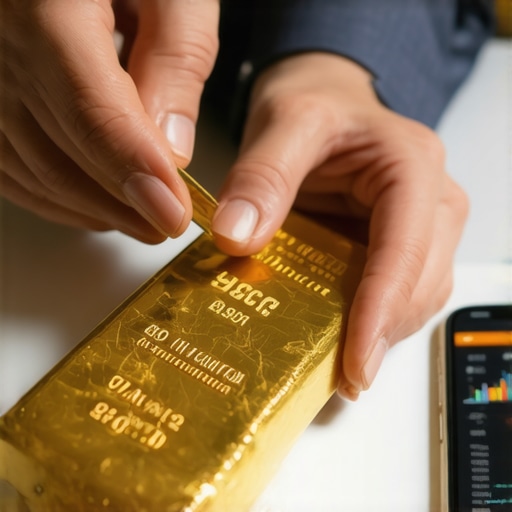Understanding Gold Investment Basics
Investing in gold has become an increasingly popular choice for individuals looking to diversify their portfolios. With its historical significance as a store of value, gold offers a hedge against inflation and market volatility, making it a compelling option for both novice and seasoned investors. As we approach 2025, understanding the nuances of gold investment is crucial for those aiming to navigate the complexities of this precious metal market.
Why Invest in Gold?
Gold has long been viewed as a safe haven asset, especially during economic downturns or periods of uncertainty. Its intrinsic value is not only derived from its physical properties but also from its cultural significance and demand in various industries. Moreover, during times of inflation, gold tends to retain its purchasing power, which is why many investors consider it a crucial part of their diversified investment portfolio.
For beginners, understanding the reasons behind investing in gold can provide a solid foundation for making informed decisions. Whether you are considering gold ETFs, physical gold, or gold mining stocks, each option has its advantages and challenges that require careful consideration.
Types of Gold Investments
There are several ways to invest in gold, each with its unique characteristics:
1. Physical Gold
Buying physical gold, such as coins or bars, allows investors to hold a tangible asset. However, it comes with additional responsibilities, including secure storage and insurance. It’s essential to choose reputable dealers and understand the market prices to make wise purchases.
2. Gold ETFs
Exchange-traded funds (ETFs) offer a more accessible way to invest in gold without the need to handle physical assets. Gold ETFs track the price of gold bullion and trade like stocks on exchanges. This option is particularly appealing for beginners due to its liquidity and lower transaction costs.
3. Gold Mining Stocks
Investing in companies that mine gold can provide exposure to gold prices while also allowing for potential capital appreciation. However, investing in mining stocks comes with its risks, as company performance can be affected by factors beyond gold prices, such as operational efficiency and management decisions.
Key Considerations for Beginners
Before diving into gold investments, beginners should consider several key factors:
1. Market Trends
Understanding current market trends is vital. 2025 gold price forecasts suggest that various economic factors, including geopolitical events and inflation rates, could significantly impact gold prices.
2. Investment Strategy
Establishing a clear investment strategy tailored to your financial goals and risk tolerance is crucial. Whether you prefer long-term investments or short-term trading, aligning your approach with your objectives will help in making informed decisions.
3. Diversification
While gold can be a valuable addition to your portfolio, it should not be the sole focus. Diversifying your investments across various asset classes can mitigate risks and enhance overall returns.
Evaluating Gold Investment Strategies
As you embark on your journey to invest in gold, it’s vital to evaluate different gold investment strategies. This process involves understanding how each option aligns with your personal financial goals and risk appetite.
1. Timing the Market
One critical aspect of investing in gold is recognizing the right time to buy. Market analysts recommend closely monitoring gold price forecasts to identify optimal buying opportunities. Economic indicators, such as inflation rates and interest rates, can influence gold prices, so staying informed is essential.
2. Dollar-Cost Averaging
For beginners, employing a dollar-cost averaging strategy can be particularly beneficial. This approach involves investing a fixed amount of money in gold at regular intervals, regardless of the price fluctuations. By doing so, you can mitigate the risks associated with market volatility and avoid the stress of trying to time the market.
Understanding Gold Demand Trends
The dynamics of gold demand play a significant role in its pricing. It’s essential for investors to grasp how various factors influence the market. For instance, global demand trends can affect the supply and demand equilibrium, leading to price fluctuations.
1. Geopolitical Factors
Geopolitical tensions often drive investors towards gold as a safe haven asset. Events such as conflicts, trade wars, and political instability can lead to increased gold purchases, pushing prices higher. Understanding these dynamics can enhance your investment strategy, allowing you to capitalize on potential price surges.
2. Economic Indicators
Monitoring economic indicators, such as currency strength and inflation, is vital for predicting gold demand. A weakening currency typically increases gold prices, as investors seek to preserve their purchasing power. Keeping an eye on these indicators will help you make informed decisions about your gold investments.
Managing Risks in Gold Investments
Like any investment, gold comes with its own set of risks. Understanding these risks is crucial to safeguarding your investments.
1. Price Volatility
Gold prices can be volatile, influenced by factors such as market sentiment and economic shifts. It is essential to be prepared for sudden price changes and to have a strategy in place to manage these fluctuations effectively.
2. Storage and Insurance Costs
If you choose to invest in physical gold, consider the costs associated with storage and insurance. Properly securing your gold investments adds an additional layer of expense that needs to be factored into your overall strategy. Researching the best practices for buying gold from reputable dealers can also help mitigate risks associated with counterfeit products.
Long-Term vs. Short-Term Investing
Deciding whether to take a long-term or short-term approach to gold investment is a critical decision. Each strategy offers distinct advantages and drawbacks.
1. Long-Term Investment
Long-term investing in gold typically involves holding onto your assets for several years or even decades. This strategy allows you to ride out market volatility and benefit from potential price increases over time. It aligns well with those looking for stability in their investment portfolio.
2. Short-Term Trading
On the other hand, short-term trading can be more lucrative for those who are knowledgeable about market trends and are willing to take calculated risks. This approach requires a keen understanding of the market dynamics and constant monitoring of price fluctuations.
As you continue to navigate through your gold investment journey, remember that each decision should align with your financial goals. As the market evolves, staying updated on current trends and strategies will enhance your ability to make informed choices. For more insights into gold trading techniques, consider exploring effective trading strategies that can help maximize your investment returns.
Advanced Strategies for Gold Investment in 2025
As investors delve deeper into the world of gold, adopting advanced strategies can significantly enhance their prospects for returns. Recognizing the intricate factors that influence gold prices can lead to more informed investment choices. In this section, we will explore various advanced strategies that align with the evolving market landscape.
1. Utilizing Gold Options and Futures
For those looking to capitalize on market movements, investing in gold options and futures can be a lucrative strategy. These financial instruments allow investors to hedge against price fluctuations or speculate on future price movements. Understanding the mechanics of these contracts is vital, as they can amplify both profits and losses. Traders should keep an eye on the latest price forecasts to make timely decisions.
2. Exploring Gold-Backed Securities
Gold-backed securities provide another pathway for investors seeking exposure to gold without the need to hold the physical metal. These securities are typically tied to the value of gold and can be purchased through various financial institutions. They offer the advantage of liquidity while still reflecting gold price movements. Investors should consider the benefits of gold ETFs and mutual funds as viable alternatives for gaining exposure to gold.
Analyzing Market Psychology in Gold Trading
Understanding market psychology is crucial for navigating the complexities of gold trading. Investors often react to news and events that can sway market sentiment, thus impacting gold prices.
1. Sentiment Analysis
Sentiment analysis involves gauging the market’s mood and can provide insights into potential price movements. Tools such as news sentiment trackers and social media analytics can help investors anticipate shifts in demand. For instance, significant geopolitical events often lead to increased demand for gold as a safe haven, prompting investors to adjust their strategies accordingly.
2. Behavioral Finance
Behavioral finance examines how psychological factors influence investor decisions. Recognizing common biases, such as overconfidence or loss aversion, can help investors make more rational choices. By understanding their own psychological triggers, investors can better navigate the emotional aspects of trading gold.
Impact of Global Economic Indicators on Gold Prices
Global economic indicators play a pivotal role in determining gold prices. Investors should keep a close watch on various metrics that can influence market dynamics.
1. Inflation Rates
High inflation typically drives investors towards gold, as it is perceived as a hedge against the eroding purchasing power of currency. Monitoring inflation trends and central bank policies can provide valuable insights for investors looking to time their gold purchases effectively. For detailed insights on this topic, refer to our predictions for gold as an inflation hedge.
2. Interest Rates
Interest rates have a direct impact on gold prices. As rates rise, the opportunity cost of holding gold increases, which can lead to lower demand. Conversely, lower interest rates typically boost gold’s appeal. Investors should regularly assess key factors influencing gold prices to refine their investment strategies.
Preparing for Market Volatility
The gold market is inherently volatile, and preparing for fluctuations is essential for any investor. Having a robust risk management strategy can help mitigate potential losses.
1. Setting Stop-Loss Orders
Implementing stop-loss orders can protect your investments against significant downturns. This strategy automatically sells your gold assets when they reach a predetermined price, minimizing potential losses. It’s an effective way to manage risk, especially in a volatile market.
2. Diversifying Gold Investments
While gold can be a strong component of an investment portfolio, diversifying across different asset classes can reduce overall risk. Consider combining gold with stocks, bonds, and other commodities to create a balanced approach to investing.
Understanding the Role of Gold in a Diversified Portfolio
As investors approach the critical year of 2025, the importance of integrating gold into a diversified portfolio becomes increasingly evident. Gold not only acts as a hedge against inflation but also provides stability during periods of economic uncertainty. A well-rounded investment strategy should encompass various asset classes, including gold, to mitigate risks and enhance overall returns.
Benefits of Including Gold in Your Portfolio
Incorporating gold into your investment mix offers several advantages:
- Inflation Protection: Gold has historically maintained its value, especially during inflationary periods, making it an effective safeguard for purchasing power.
- Risk Diversification: By adding gold to your portfolio, you reduce dependence on traditional stocks and bonds, which can be more volatile during market downturns.
- Safe Haven Asset: In times of geopolitical instability or economic distress, gold often sees increased demand, providing a buffer against market fluctuations.
Current Trends in Gold Demand for 2025
Understanding market trends is crucial for investors looking to capitalize on gold opportunities. Various factors influence gold demand, and staying informed can enhance decision-making. Recent analyses reveal evolving trends that could impact gold prices significantly in 2025.
1. Economic Recovery and Gold Demand
As global economies recover from recent disruptions, gold demand is expected to increase. Investors seeking a safe haven may flock to gold as a reliable asset. Monitoring economic indicators and demand trends can provide insights into potential price movements.
2. Central Bank Purchases
Central banks worldwide have been increasing their gold reserves as a strategic move to bolster national currencies. This trend not only influences market sentiment but also signals a strong belief in gold’s long-term value. Keeping an eye on central bank strategies can help investors gauge future demand dynamics.
Evaluating Gold Investment Strategies in 2025
As we enter 2025, various strategies for investing in gold will emerge. Each approach has its unique advantages and risks, and understanding these can help investors make informed choices.
1. Long-Term Holding vs. Active Trading
Deciding whether to adopt a long-term holding strategy or engage in active trading is crucial. Long-term investors may benefit from holding gold through market fluctuations, while traders can capitalize on short-term price movements. Exploring resources on successful gold investments can offer additional insights into both strategies.
2. Utilizing Gold ETFs and Mutual Funds
For those who prefer not to manage physical gold, investing in gold ETFs and mutual funds presents an attractive alternative. These investment vehicles offer exposure to gold prices while providing liquidity and ease of management. Understanding the nuances of gold ETFs can help investors choose the best options for their portfolios.
Conclusion: Preparing for a Successful Gold Investment Journey
As the landscape of gold investment evolves, staying informed and strategic is key. Whether you are a novice or an experienced investor, understanding gold’s role in your portfolio, current demand trends, and tailored investment strategies will enhance your chances of success. Embrace the insights shared in this guide and prepare for a prosperous investment journey in 2025.
Frequently Asked Questions About Gold Investment
1. What are the benefits of investing in gold in 2025?
Investing in gold in 2025 offers several benefits, including inflation protection, portfolio diversification, and the ability to act as a safe haven during geopolitical uncertainties. Gold has historically maintained its value and can provide stability in volatile markets.
2. How can I start investing in gold as a beginner?
To start investing in gold, beginners can explore various options such as purchasing physical gold (coins and bars), investing in gold ETFs, or buying shares in gold mining companies. Researching the market and understanding the different investment types is crucial for making informed decisions.
3. Is gold a good long-term investment?
Yes, gold is often considered a good long-term investment due to its historical resilience against inflation and market volatility. Many investors hold gold as a part of a diversified portfolio to safeguard their wealth over time.
4. What are the risks associated with gold investment?
Gold investment risks include price volatility, storage and insurance costs for physical gold, and the potential for market manipulation. Understanding these risks and implementing strategies to manage them is essential for successful investing.
5. How do geopolitical events affect gold prices?
Geopolitical events often drive demand for gold as a safe haven asset. During times of conflict, economic instability, or significant political changes, investors tend to flock towards gold, which can lead to price increases.
6. What role do central banks play in gold investment?
Central banks influence gold prices through their buying and selling activities. Increased gold purchases by central banks can signal a strong belief in gold’s value and may lead to higher market prices as demand increases.
7. Can I invest in gold through my retirement account?
Yes, many investors can include gold in their retirement accounts through self-directed IRAs, which allow for investments in physical gold, gold ETFs, and other precious metals. It’s important to consult with a financial advisor to understand the rules and options available.
8. What is the difference between gold ETFs and physical gold?
Gold ETFs are traded like stocks and provide exposure to gold prices without the need to hold physical metal. In contrast, physical gold involves purchasing actual coins or bars, which requires secure storage and insurance. Each option has its own advantages and challenges, depending on your investment strategy.
9. How does inflation affect gold investment?
Inflation typically drives investors toward gold, as it is seen as a hedge against the eroding purchasing power of currency. When inflation rises, the demand for gold often increases, leading to higher prices.
10. What are some resources for further learning about gold investment?
There are many reputable resources for learning about gold investment, including financial news websites, investment blogs, and books by industry experts. Websites like Kitco, Investopedia, and The World Gold Council offer valuable insights and analyses on gold trends and investment strategies.
Authority Resources for Gold Investment Insights
For those looking to deepen their understanding of gold investment, several trusted resources provide expert insights and analyses:
- Kitco – A leading source for precious metals market news, prices, and analysis.
- Investopedia – Offers comprehensive articles and tutorials on investing, including gold and precious metals.
- The World Gold Council – Provides research and insights on gold demand and investment.
- Bloomberg – Features up-to-date financial news and market analysis, including coverage on gold prices.
- Morningstar – Offers investment research and analysis on gold ETFs and mutual funds.
Conclusion: Embrace Gold Investment in 2025
As we look toward 2025, the landscape of gold investment presents numerous opportunities for both new and experienced investors. By understanding the various investment options, market dynamics, and risk management strategies, you can make informed decisions to enhance your investment portfolio. Embrace the insights shared in this guide to navigate your gold investment journey successfully, ensuring that you harness the benefits of this precious metal as a reliable asset.









